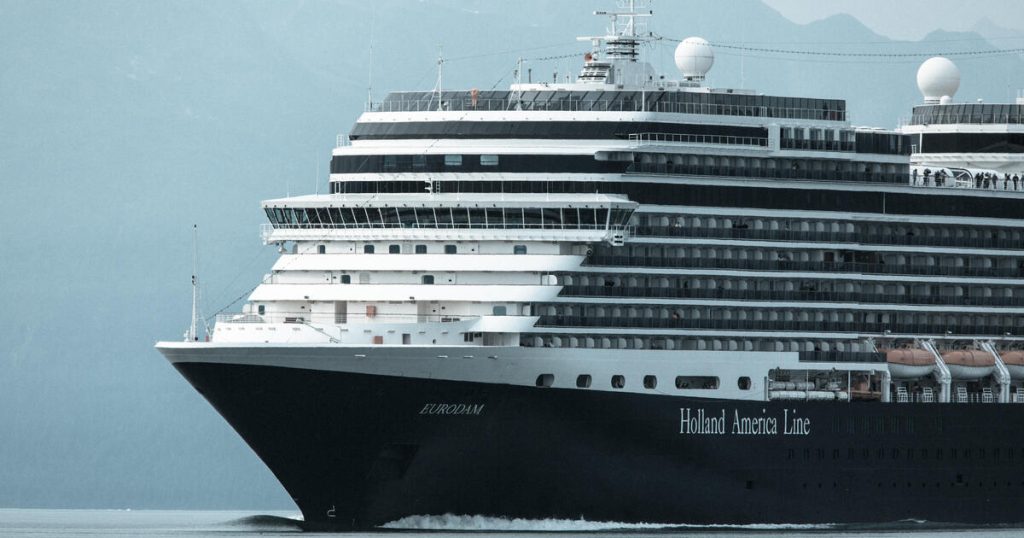A recent outbreak of norovirus has sickened dozens of passengers and crew on the Holland America Line’s Eurodam, prompting heightened sanitation measures. The cruise ship, which departed from Port Everglades, Florida, on February 19, is currently on a 10-day tour of the Caribbean. With a total of 79 passengers and 9 crew members reporting illness, officials are monitoring the situation closely.
| Article Subheadings |
|---|
| 1) Overview of the Norovirus Situation |
| 2) The Response by Holland America Line |
| 3) Norovirus and Its Symptoms |
| 4) Trends in Norovirus Infections |
| 5) Previous Outbreaks in the Cruise Industry |
Overview of the Norovirus Situation
As of now, nearly 88 individuals from the Holland America Line’s Eurodam have reported symptoms consistent with norovirus infection. This includes a significant portion of the cruise’s population consisting of 2,057 passengers and 834 crew members. The rapid spread of illness on the ship highlights the highly contagious nature of norovirus as confirmed by the Centers for Disease Control and Prevention (CDC). The Eurodam is on a scheduled 10-day Caribbean cruise, with its return to Florida expected by March 1. To ensure the safety and well-being of everyone onboard, the crew has initiated a series of sanitation protocols aimed at containing the outbreak.
The Response by Holland America Line
In response to the outbreak, Holland America Line has activated its increased cleaning protocols. These measures include extensive sanitization of commonly touched surfaces and the isolation of all passengers and crew members who exhibited symptoms of the virus. Furthermore, the crew collected stool specimens for analysis in coordination with the Vessel Sanitation Program to identify the specific strain causing the outbreak. They are maintaining close communication with health authorities, ensuring that handlers quickly address any rise in reported illnesses among passengers and staff during the journey. The proactive strategy emphasizes the importance of prompt action in handling public health concerns aboard cruise ships.
Norovirus and Its Symptoms
Norovirus is known for its rapid transmission and can spread through contaminated food, water, surfaces, or close contact with infected individuals. Symptoms typically manifest as diarrhea, vomiting, nausea, and stomach pain, often accompanied by fever, headaches, and body aches. Most times, those infected begin to feel better within a matter of one to three days; however, they remain contagious for a few days longer. The CDC has noted that while the symptoms can be distressing, the virus is usually self-limiting and not fatal in healthy individuals. However, vulnerable populations, particularly the elderly or those with weakened immune systems, may face greater risks, including severe dehydration.
Trends in Norovirus Infections
This year, a marked increase in the number of norovirus infections has been reported across the United States, particularly in January, where the cases more than doubled compared to the previous year. Health officials attribute this surge to seasonal factors and increased human interactions during winter holidays. The contagious nature of norovirus means public places, including cruise ships, can easily become breeding grounds for outbreaks. The CDC’s proactive measures are crucial in educating the public and minimizing infection spread, as awareness and hygiene practices play an essential role in controlling such outbreaks.
Previous Outbreaks in the Cruise Industry
The Eurodam is not the first Holland America Line ship to face a norovirus outbreak this month. Just weeks earlier, the Rotterdam, which also sailed from Port Everglades on February 2, reported 19 crew members and 166 passengers affected. This incident underscores a worrying trend as multiple vessels operated by the same cruise company encounter similar health challenges. In fact, the Vessel Sanitation Program noted other outbreaks this year, including an incident involving Princess Cruises’ Coral Princess, where 128 passengers were affected, as well as an outbreak on Viking Ocean Cruises’ Viking Mars, affecting 62 passengers. These incidents reflect broader concerns within the cruise industry regarding health protocols and emergency response strategies.
| No. | Key Points |
|---|---|
| 1 | Seventy-nine passengers and nine crew members on the Eurodam have been reported ill due to norovirus. |
| 2 | The ship is adhering to enhanced cleaning protocols and isolating those affected. |
| 3 | Norovirus symptoms include diarrhea, vomiting, and nausea, with recovery typically within 1-3 days. |
| 4 | The U.S. is experiencing a surge in norovirus cases this year, with rates more than double compared to previous years. |
| 5 | This outbreak adds to a series of norovirus incidents reported across different cruise lines recently. |
Summary
The outbreak of norovirus aboard the Holland America Line’s Eurodam serves as a stark reminder of the resilience of contagious illnesses in close quarters, such as cruise ships. With enhanced sanitation measures in place, the crew remains steadfast in their commitment to safeguarding the health of all onboard. As monitoring continues, officials will likely draw valuable insights from both the operational response and the public health implications of this incident. The ongoing scrutiny of health protocols within the cruise industry underscores the need for robust systems to mitigate future outbreaks.
Frequently Asked Questions
Question: What steps is Holland America Line taking to manage the outbreak?
Holland America Line is implementing increased cleaning and disinfection procedures, isolating sick passengers and crew, and collecting stool specimens for testing to help identify the virus.
Question: How is norovirus transmitted?
Norovirus can be transmitted through contaminated food and water, surfaces, or through direct contact with an infected person, making it highly contagious.
Question: What are the risks associated with norovirus for vulnerable populations?
Individuals in vulnerable populations, such as the elderly or those with weakened immune systems, are at higher risk of severe dehydration and complications resulting from norovirus infections.


